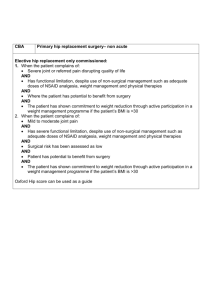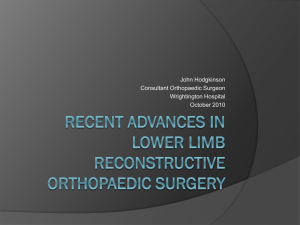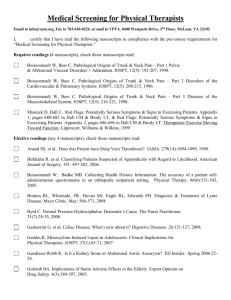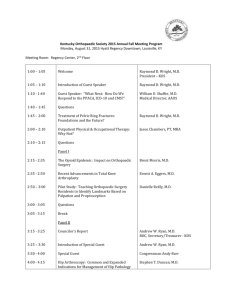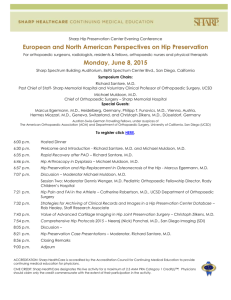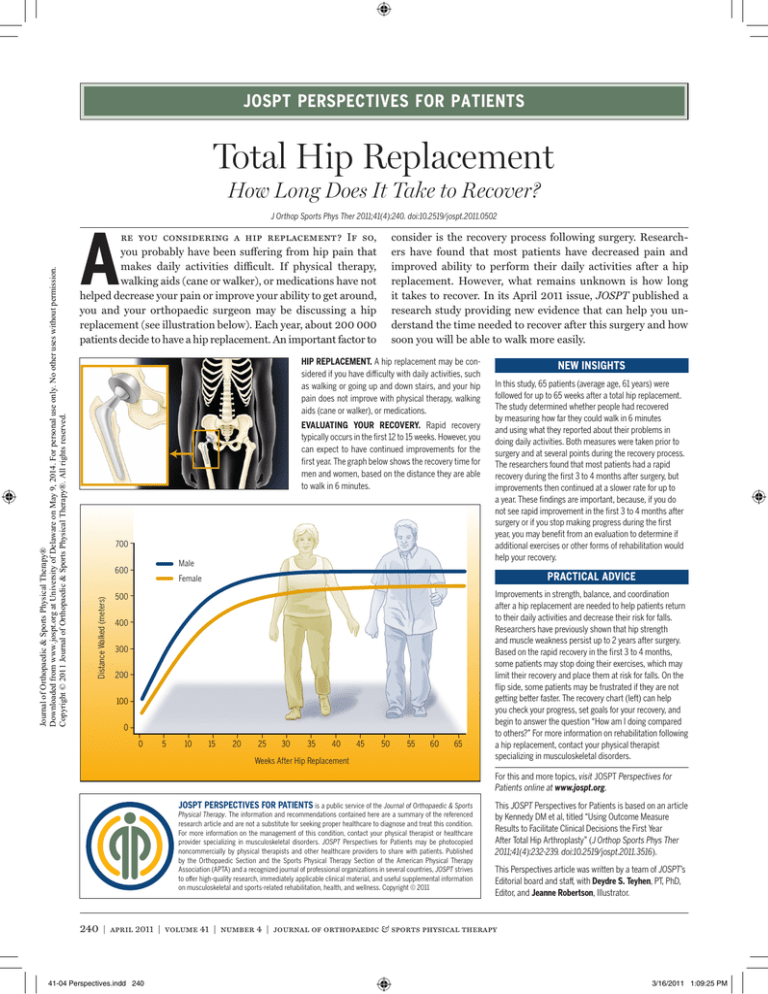
jospt perspectives for patients
Total Hip Replacement
J Orthop Sports Phys Ther 2011;41(4):240. doi:10.2519/jospt.2011.0502
A
re you considering a hip replacement? If so,
you probably have been suffering from hip pain that
makes daily activities difficult. If physical therapy,
walking aids (cane or walker), or medications have not
helped decrease your pain or improve your ability to get around,
you and your orthopaedic surgeon may be discussing a hip
replacement (see illustration below). Each year, about 200 000
patients decide to have a hip replacement. An important factor to
consider is the recovery process following surgery. Researchers have found that most patients have decreased pain and
improved ability to perform their daily activities after a hip
replacement. However, what remains unknown is how long
it takes to recover. In its April 2011 issue, JOSPT published a
research study providing new evidence that can help you understand the time needed to recover after this surgery and how
soon you will be able to walk more easily.
HIP REPLACEMENT. A hip replacement may be considered if you have difficulty with daily activities, such
as walking or going up and down stairs, and your hip
pain does not improve with physical therapy, walking
aids (cane or walker), or medications.
EVALUATING YOUR RECOVERY. Rapid recovery
typically occurs in the first 12 to 15 weeks. However, you
can expect to have continued improvements for the
first year. The graph below shows the recovery time for
men and women, based on the distance they are able
to walk in 6 minutes.
700
Male
600
Distance Walked (meters)
Journal of Orthopaedic & Sports Physical Therapy®
Downloaded from www.jospt.org at University of Delaware on May 9, 2014. For personal use only. No other uses without permission.
Copyright © 2011 Journal of Orthopaedic & Sports Physical Therapy®. All rights reserved.
How Long Does It Take to Recover?
NEW INSIGHTS
In this study, 65 patients (average age, 61 years) were
followed for up to 65 weeks after a total hip replacement.
The study determined whether people had recovered
by measuring how far they could walk in 6 minutes
and using what they reported about their problems in
doing daily activities. Both measures were taken prior to
surgery and at several points during the recovery process.
The researchers found that most patients had a rapid
recovery during the first 3 to 4 months after surgery, but
improvements then continued at a slower rate for up to
a year. These findings are important, because, if you do
not see rapid improvement in the first 3 to 4 months after
surgery or if you stop making progress during the first
year, you may benefit from an evaluation to determine if
additional exercises or other forms of rehabilitation would
help your recovery.
PRACTICAL ADVICE
Female
500
400
300
200
100
0
0
5
10
15
20
25
30
35
40
45
50
55
60
65
Weeks After Hip Replacement
Improvements in strength, balance, and coordination
after a hip replacement are needed to help patients return
to their daily activities and decrease their risk for falls.
Researchers have previously shown that hip strength
and muscle weakness persist up to 2 years after surgery.
Based on the rapid recovery in the first 3 to 4 months,
some patients may stop doing their exercises, which may
limit their recovery and place them at risk for falls. On the
flip side, some patients may be frustrated if they are not
getting better faster. The recovery chart (left) can help
you check your progress, set goals for your recovery, and
begin to answer the question “How am I doing compared
to others?” For more information on rehabilitation following
a hip replacement, contact your physical therapist
specializing in musculoskeletal disorders.
For this and more topics, visit JOSPT Perspectives for
Patients online at www.jospt.org.
JOSPT PERSPECTIVES FOR PATIENTS is a public service of the Journal of Orthopaedic & Sports
Physical Therapy. The information and recommendations contained here are a summary of the referenced
research article and are not a substitute for seeking proper healthcare to diagnose and treat this condition.
For more information on the management of this condition, contact your physical therapist or healthcare
provider specializing in musculoskeletal disorders. JOSPT Perspectives for Patients may be photocopied
noncommercially by physical therapists and other healthcare providers to share with patients. Published
by the Orthopaedic Section and the Sports Physical Therapy Section of the American Physical Therapy
Association (APTA) and a recognized journal of professional organizations in several countries, JOSPT strives
to offer high-quality research, immediately applicable clinical material, and useful supplemental information
on musculoskeletal and sports-related rehabilitation, health, and wellness. Copyright © 2011
This JOSPT Perspectives for Patients is based on an article
by Kennedy DM et al, titled “Using Outcome Measure
Results to Facilitate Clinical Decisions the First Year
After Total Hip Arthroplasty” (J Orthop Sports Phys Ther
2011;41(4):232-239. doi:10.2519/jospt.2011.3516).
This Perspectives article was written by a team of JOSPT’s
Editorial board and staff, with Deydre S. Teyhen, PT, PhD,
Editor, and Jeanne Robertson, Illustrator.
240 | april 2011 | volume 41 | number 4 | journal of orthopaedic & sports physical therapy
41-04 Perspectives.indd 240
3/16/2011 1:09:25 PM


